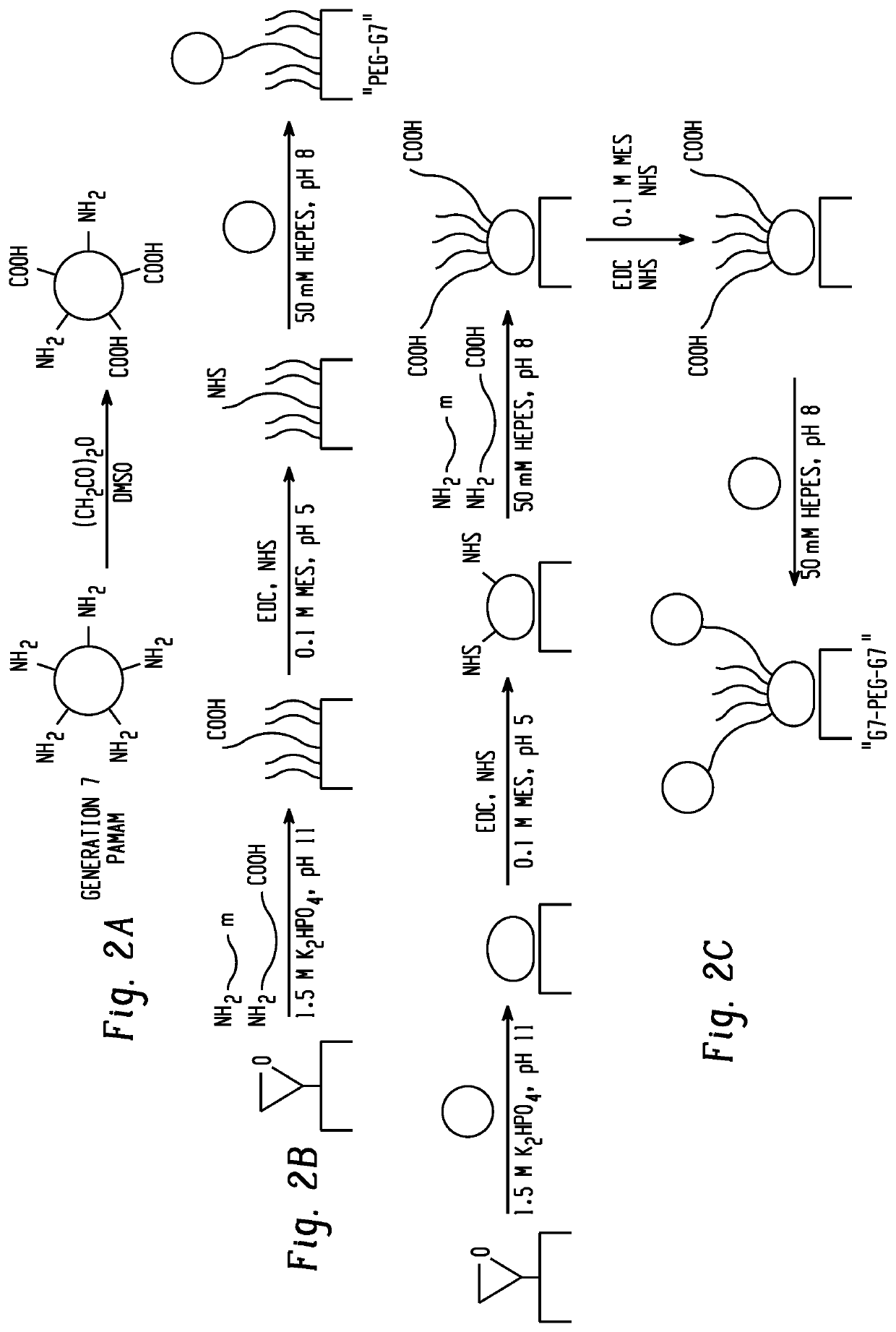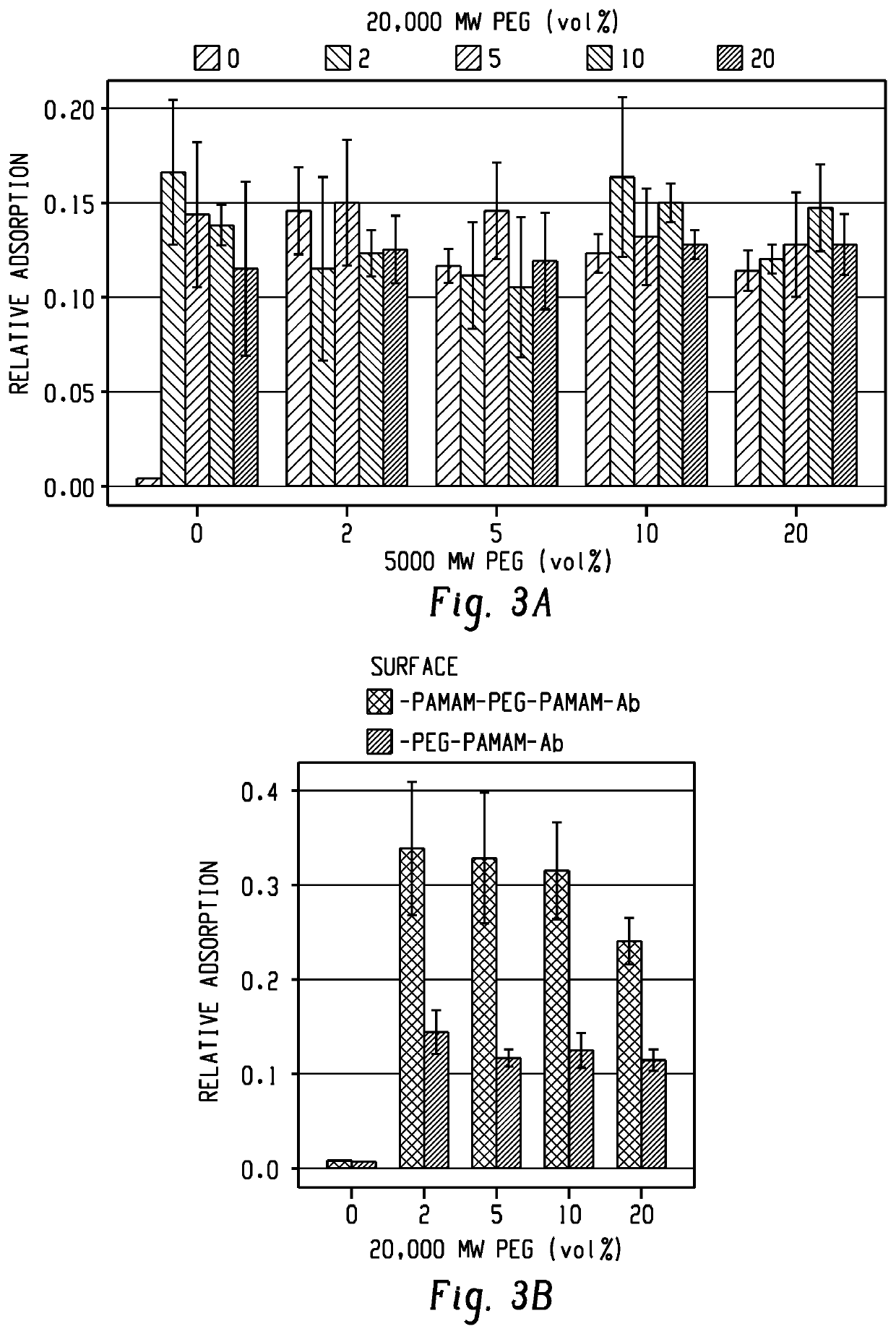Nanoengineered surfaces for cancer biomarker capture
a biomarker and nano-engineered technology, applied in the field of surfaces, can solve the problems of difficult isolating and identifying exosome materials, and achieve the effect of reducing non-specific binding and low molecular weigh
- Summary
- Abstract
- Description
- Claims
- Application Information
AI Technical Summary
Benefits of technology
Problems solved by technology
Method used
Image
Examples
example 1
on of Capture Surfaces
[0109]Capture surfaces for the capture of exosomes included epoxide-functionalized glass coated with partially-carboxylated, generation 7 (G7), poly(amidoamine) dendrimer nanoparticles. The G7 layer was functionalized with a mixture of heterobifunctional polyethylene glycol tethers (PEG) and shorter methoxy-PEG to minimize nonspecific interactions. The PEG tethers were then capped with G7 (FIG. 2). Preliminary experiments with 200 nm functionalized polystyrene beads suggested that a mixture of 0.5 μM 20,000 MW carboxy-PEG-amine, 2 μM 5,000 MW carboxy-PEG-amine, and 240 μM 2,000 MW methoxy-PEG-amine (1:1:48 by mass concentration) resulted in adequate capture rates (FIG. 3). In previous work, antibodies conjugated to PEG-tethered poly(amidoamine) (referred to here as PEG-G7) were shown to be more effective in capturing circulating tumor cells compared with controls with PEG alone (-PEG). In this work, surfaces pre-coated with polyamidoamine are referred to as G7-...
example 2
apture
[0111]The various polymer surface configurations were initially screened using exosome-sized beads. Polystyrene beads nominally 200 nm in diameter (Thermo Fisher FluoSphere™) were coated with recombinant Epithelial-Cell-Adhesion-Molecule (EpCAM, R&D Systems), a commonly-targeted surface antigen for circulating tumor materials. Capture surfaces with various G7 dendrimers and PEG configurations were functionalized with antibodies against EpCAM (aEpCAM, R&D Systems). Our results shown in FIG. 7a revealed significantly higher capture efficiency, as measured by increased fluorescent intensity, on the surfaces with two layers of dendrimers (G7-PEG-G7), compared to those with a single layer of dendrimers (PEG-G7). This enhancement was mostly pronounced when 2% of tethering, longer PEG (20 kDa) was added on the surface with shorter PEG (5 kDa), which shows an agreement with our previous observation using micelles. An increase of the content of the tethering PEG (5-20%) did not result ...
PUM
| Property | Measurement | Unit |
|---|---|---|
| molecular weight | aaaaa | aaaaa |
| molecular weight | aaaaa | aaaaa |
| molecular weight | aaaaa | aaaaa |
Abstract
Description
Claims
Application Information
 Login to View More
Login to View More - R&D
- Intellectual Property
- Life Sciences
- Materials
- Tech Scout
- Unparalleled Data Quality
- Higher Quality Content
- 60% Fewer Hallucinations
Browse by: Latest US Patents, China's latest patents, Technical Efficacy Thesaurus, Application Domain, Technology Topic, Popular Technical Reports.
© 2025 PatSnap. All rights reserved.Legal|Privacy policy|Modern Slavery Act Transparency Statement|Sitemap|About US| Contact US: help@patsnap.com



